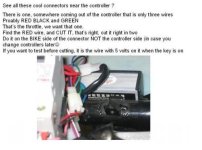Hi all,
Sorry for the newbish questions - does anyone know where I can find any step by step instructions for on how to actually wire up the Stand Alone Cycle Analyst so that I can use its advanced current limiting functions?
I've blown out 3 Dewalt 36 volt batteries so far. But....I'm getting tired of disassembling them and recharging individual cells.
So, want to get the Stand-Alone Cycle Analyst working to its full capabilities and limit the current.
My SA CA is currently hooked up to a 72 volt, 35 amp controller like this one here: http://www.poweridestore.com/35A36V-72V-X-5-Motor-Controller
I followed these instructions to hook it up in basic mode and it works just fine:
http://www.ebikes.ca/drainbrain.shtml (step 7)
I have seen these instructions:
http://visforvoltage.org/forum/2619-cycle-analyst-used-control-and-extending-range
Which I'm a little concerned about following - even the more spelled out directions if you scroll down.
Here are the orginal instructions for how to take advantage of the current limit - if someone can hook me up with pictures showing step by step on how to do this?
Throttle Over-Ride Details
In order to take advantage of the speed limit, current limit, and low voltage cutout, the Cycle Analyst needs to be wired in such a way that the throttle-override output is able to take charge of the motor controller when one of the limits is surpassed. The output is a stiff analog voltage that can range from 5V down to 0V. When it detects that a limit is exceeded, the voltage begins to ramp down from its resting point (set by ItermMax), until power to the motor is reduced and the limit (speed, current, or voltage) is no longer exceeded.
By comparison, the user typically has a throttle signal that varies from close to 0 or 1V when it is off, up to 4-5 V when the throttle is fully engaged. For proper operation, the signal for the motor controller should be the lower of these two voltages. An easy way to achieve this is with a diode and current limiting resistor on the throttle line as shown in the following schematic:
Sorry for the newbish questions - does anyone know where I can find any step by step instructions for on how to actually wire up the Stand Alone Cycle Analyst so that I can use its advanced current limiting functions?
I've blown out 3 Dewalt 36 volt batteries so far. But....I'm getting tired of disassembling them and recharging individual cells.
So, want to get the Stand-Alone Cycle Analyst working to its full capabilities and limit the current.
My SA CA is currently hooked up to a 72 volt, 35 amp controller like this one here: http://www.poweridestore.com/35A36V-72V-X-5-Motor-Controller
I followed these instructions to hook it up in basic mode and it works just fine:
http://www.ebikes.ca/drainbrain.shtml (step 7)
I have seen these instructions:
http://visforvoltage.org/forum/2619-cycle-analyst-used-control-and-extending-range
Which I'm a little concerned about following - even the more spelled out directions if you scroll down.
Here are the orginal instructions for how to take advantage of the current limit - if someone can hook me up with pictures showing step by step on how to do this?
Throttle Over-Ride Details
In order to take advantage of the speed limit, current limit, and low voltage cutout, the Cycle Analyst needs to be wired in such a way that the throttle-override output is able to take charge of the motor controller when one of the limits is surpassed. The output is a stiff analog voltage that can range from 5V down to 0V. When it detects that a limit is exceeded, the voltage begins to ramp down from its resting point (set by ItermMax), until power to the motor is reduced and the limit (speed, current, or voltage) is no longer exceeded.
By comparison, the user typically has a throttle signal that varies from close to 0 or 1V when it is off, up to 4-5 V when the throttle is fully engaged. For proper operation, the signal for the motor controller should be the lower of these two voltages. An easy way to achieve this is with a diode and current limiting resistor on the throttle line as shown in the following schematic:



